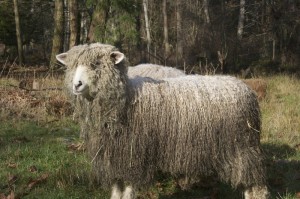Why wool from Heritage Sheep? What the heck are Heritage Sheep anyway?
Modern agricultural practices have evolved into enormous commercial enterprises. Farming practices favor the use of a small number of specialized breeds, intensively raised in a carefully controlled environment. The focus: maximum ‘product’ output. Surprise! This product output isn’t limited to meat. Merino wool anyone?! What about angora? Okay, now does anyone have a Cotswold sweater? No? How about a rug from Karakul wool?
Don’t get me wrong, I love merino wool, and angora, and don’t get me started on the feel of silk on one’s skin. These are, however, animals that are widely raised and products which are widely available in every wool and yarn store in the world. The heritage breeds tend to be raised by small farmers, in smaller flocks. Their wool tends to be available more locally, (although the web has helped to change this), processed by hand or in smaller mills, and a little more expensive. That is, if the farmer has any time to think about selling and marketing the wool at all.
I have spent nearly ten years raising heritage sheep. The sheep themselves, their health, their personalities, are extraordinary. Their wool is even more so. After wading through the difficult maze of wool processing I have discovered that there really is a large number of people, handspinners, knitters, felters…, who are eager to work with heritage wool. I have also found that many of the farmers that raise heritage sheep need or want help to sell the wool.
So, welcome to the birth of the Fiddlehead Farm Studio. We have mainly wool from our own sheep – Cotswold, Shetland and one or two beautiful crosses of these two breeds. Soon we will be stocking wool from other farmers, and other heritage sheep. We hope to benefit not only farmers, but those workers of wool who crave something a little different, a little hard to find. Something which will in it’s purchase not only provide you pleasure, but support sheep which are endangered or teetering on the edge of extinction. Traditional animals which are a link to our past, and an important resource for our future.

